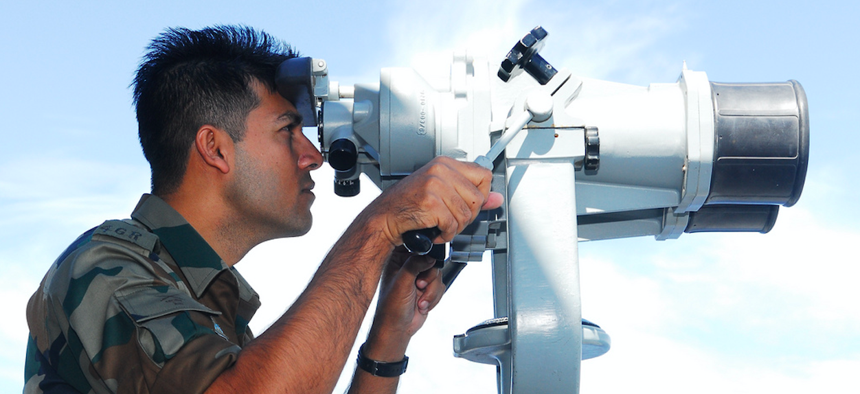
An Indian army major looks through “the big eyes” on the bridge of the amphibious assault ship USS Essex during a joint exercise. The nominee to head PACOM said he'll devote "great energy" to the U.S.-India relationship. Mass Communication Specialist 3rd Class Andrew Ryan Smith/U.S. Navy
Three Things to Watch from the PACOM’s (Likely) Next Commander
The current leader of U.S. Fleet Forces command says he would work on the U.S.-India relationship “with great energy.”
The man tapped to lead U.S. Pacific Command says the region contains four of the five threats identified in the National Defense Strategy — and one of the most promising strategic relationships.
“I think the historic opportunity for the United States going forward is probably with India,” Adm. Philip Davidson told lawmakers Tuesday in his joint-confirmation hearing before the Senate Armed Services Committee. “That would be a relationship that I intend to work on with great energy.”
That means building up the military-to-military relationship, Davidson said, and helping India move on from its historical reliance on Russian weapons. The Trump administration has supported a push to sell India U.S. fighter jets as a way of deepening the cooperation with the world’s most populous democracy and counterbalancing China.
“India's military has long relied on the former Soviet Union, and then Russia, for some of their technology and training,” he said. “We have to break down that historical background, to a certain extent — break down is not the correct word, but be willing to work with that so we can move forward with India.”
A careful line with Taiwan
Keep an eye on the U.S. military’s level of engagement with Taiwan, which senators have been pushing to deepen in the face of a rising China. Last month, SASC’s No. 2 Republican, Oklahoma’s Jim Inhofe, encouraged the Trump administration to sell Taiwan F-35 stealth fighters — or, barring that unlikely move, upgraded F-16Vs.
Today, Sen. Tom Cotton, R-Ark., asked Davidson if he would support port calls between the Taiwanese and U.S. navies. The nominee didn’t have any immediate thoughts on “new initiatives,” but said he would report back.
“We have not in our recent past, Senator. I understand that's something to discuss now,” he said. “I haven't talked about it with [current PACOM chief] Admiral [Harry] Harris at any extent. I look forward to having that conversation across the interagency here and with the Congress.”
Ditto for having Taiwan participate in military exercises in the Indo-Pacific.
China’s hypersonic weapons
It’s “essential” the U.S. develop new hypersonic missiles, Davidson told the committee. Not only because “hypersonic and directed energy weapons, resilient space, cyber and network-capabilities, and well trained [troops] will be crucial to our ability to fight and win” future wars, but also because America is currently falling behind potential adversaries in the region.
“I'm highly concerned about China's pursuit of hypersonics,” Davidson said.
He’s not the only one. Gen. John Hyten, the commander of U.S. Strategic Command, told lawmakers last month that the U.S. would have a hard time stopping a hypersonic missile if China or Russia launched one.
“That is one area we need to get at quickly,” Davidson said today. “Some help there on the acquisition side would allow us to innovate more quickly.”
Davidson, who currently leads Fleet Forces Command, has served multiple tours in the Pacific, including two on the U.S. Pacific Fleet staff. He would replace Harris, who was nominated as ambassador to Australia in February.
Of the five threats to the U.S. identified in the National Defense Strategy, four are present in-theater, he acknowledged in opening remarks: long-term strategic challenges from China and Russia, plus the immediate threat posed by North Korea and violent extremist groups.
